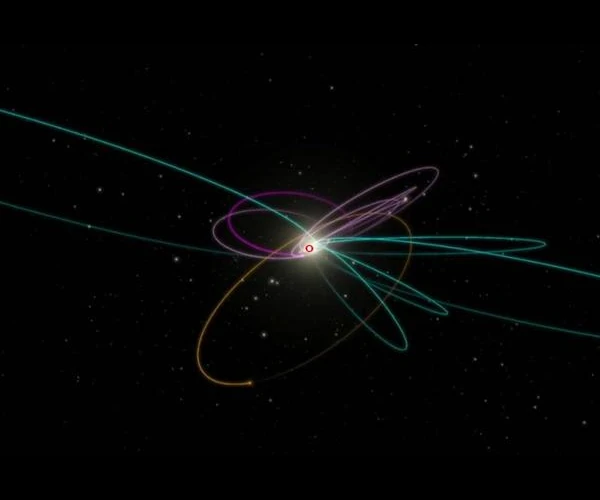
Image: Far beyond the Kuiper belt, between 300 and 500
Neptune's orbit is represented by the small red circle in the center of the image.
The theory of the existence of Planet 9 has been proposed to explain certain anomalies observed in the orbits of certain trans-Neptunian objects, in the Kuiper belt, in particular their inclination and their eccentricity. Computer simulations suggest that these alignments of the orbits of certain objects could be caused by the gravitational influence of a massive planet located far beyond Neptune.
Scientists began searching for Planet 9 in 2014, after two American astronomers, Konstantin Batygin and Mike Brown, published a study on observed disturbances in the orbits of trans-Neptunian objects. These very aligned and very similar orbits are difficult to explain without another source of gravity in the solar system. Since then, many studies have been conducted to search for evidence of the existence of Planet 9. Many ETNOs (Extreme Trans-Neptunian Objects) have since been discovered, but not Planet X.
Planet 9 is estimated to have a mass about 5 to 10 times that of Earth and orbit the Sun at a distance of about 300 to 600 astronomical units. About 10 to 20 times the distance from Neptune to the Sun.
To calculate the time required for an object to go around the Sun at a distance of 300 AU, we can use the formula T^2 = (4π^2/GM) x a^3 where T is the orbital period, G is the gravitational constant, M is the mass of the Sun, and a is the average distance from the Sun.
This means that it would take Planet 9 approximately 18,717 years to complete a full orbit around the Sun.
If the orbit of an object located at 300 AU has an eccentricity of 0.5, the object would be a minimum distance from the Sun of 150 AU and a maximum distance of 450 AU. It would take about 30,000 years to complete one revolution.
Despite intensive searches, Planet 9 has not been detected.
Some studies have questioned the very existence of Planet 9, suggesting that the observed anomalies could be caused by other factors, such as errors in measurements or interactions with unknown objects. Other studies continue to search for evidence of the existence of Planet 9, using telescopes to map the skies and analyzing data from space missions such as the Hubble Space Telescope.
Computer models cannot predict where exactly its orbit is. What it is possible to calculate is the very elliptical shape of its orbit.
Its luminosity is too low, its distance too far and its position in its orbit is not known.
It is even possible that this hypothetical planet is on the furthest part of the Sun at 500 or 600 au.
Moreover, seen from Earth, it would be on the galactic plane towards the Milky Way, the most difficult place for the detection of an object having a very weak luminous intensity. The river of bright stars behind prevents any detection of faint objects.